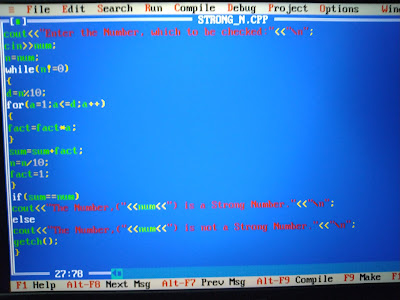We are gonna see how to write a C++ program (Turbo C++) to input Two Numbers and Swap their values without using any third/other variable than variables used to assign the two numbers, using Multiplication and Division only.
The following codes have been run and compiled in C++(Turbo C++).
The writing in the right-hand side of this "//" in the codes are called comments of the code. They are not a necessary part of the codes and can be omitted in the codes. They are just mentioned so as to tell you the use/purpose of writing the left-hand side of the "//" or the codes. In some special cases depending upon the Fond & Size of the text on your device the comments may entered the right hand-side of the "//"(next line) and come in between the main codes. so as to, make it easier for you to understand/distinguish the comments from the main codes; we have written the main code and comments in different sizes.
Example: Main codes: " #include<iostream.h> "
Comments: " //It is a header file and used to call the input-output classes(Pre-defined library in C++). " .
Example: Main codes: " #include<iostream.h> "
Comments: " //It is a header file and used to call the input-output classes(Pre-defined library in C++). " .
The Variables are user initialized with zero, so that they won't store any garbage value and hamper the final output of the program.
For more accurate result, users may replace "int" and "float" with "long" and "double" respectively.
For more accurate result, users may replace "int" and "float" with "long" and "double" respectively.
The code are as follows:
#include<iostream.h>
#include<conio.h>
void main()
{
clrscr();
long a=0,b=0;
cout<<"Enter the values of the First number(A) : "<<"\n";
cin>>a;
cout<<"Enter the values of the Second number(B) : "<<"\n";
cin>>b;
a=a*b;
b=a/b;
a=a/b;
cout<<"A ="<<a<<"\n";
cout<<"B ="<<b<<"\n";
getch();
}
Program:
Output:
Do visit again to see more Coding related blogs.
#include<iostream.h>
#include<conio.h>
void main()
{
clrscr();
long a=0,b=0;
cout<<"Enter the values of the First number(A) : "<<"\n";
cin>>a;
cout<<"Enter the values of the Second number(B) : "<<"\n";
cin>>b;
a=a*b;
b=a/b;
a=a/b;
cout<<"A ="<<a<<"\n";
cout<<"B ="<<b<<"\n";
getch();
}
Program:
 |
| Code |
Output:
 |
| Result |
 |
| Result |
Hope that the Blog have helped you in your work.
Do visit again to see more Coding related blogs.
















































